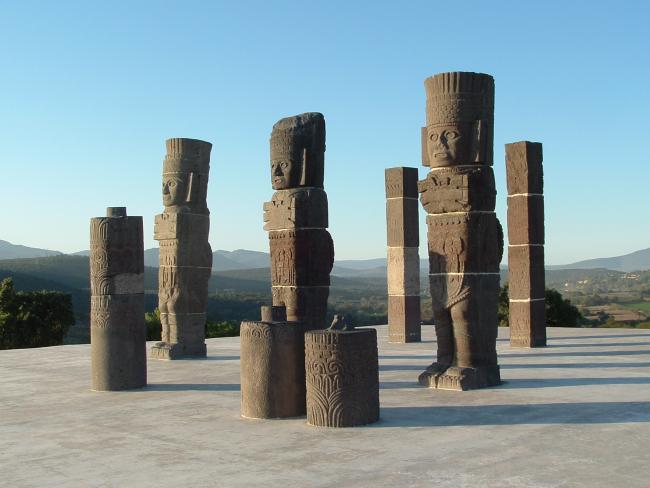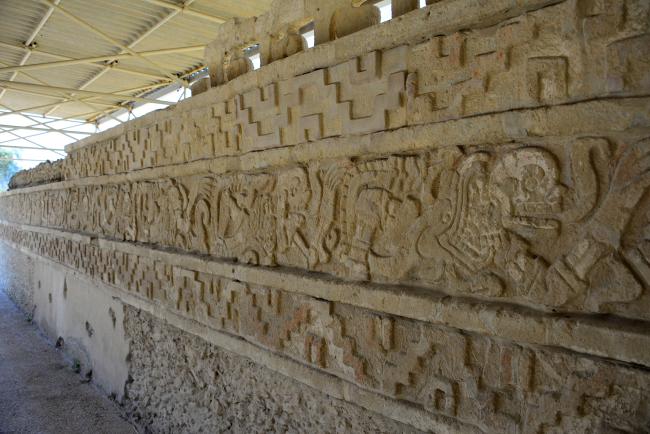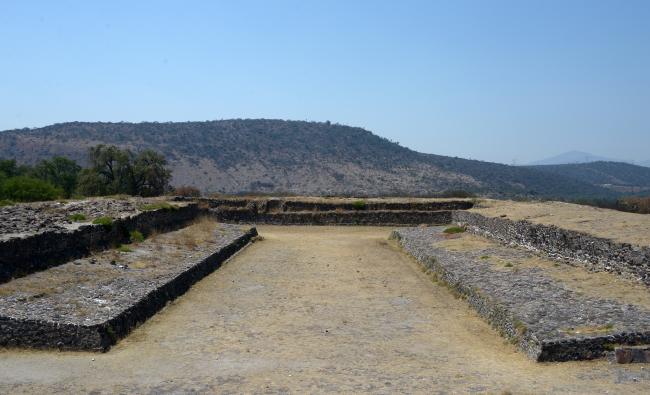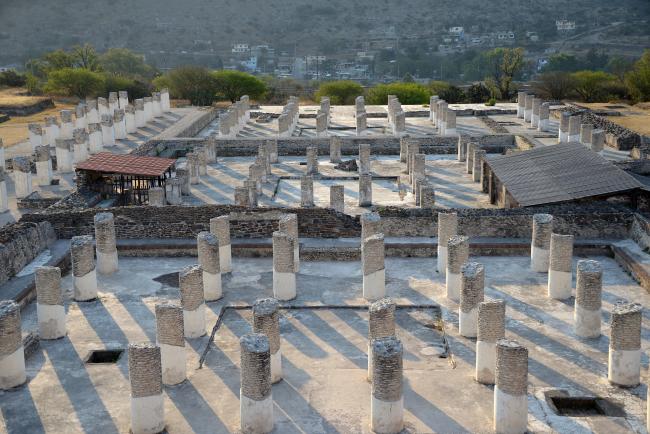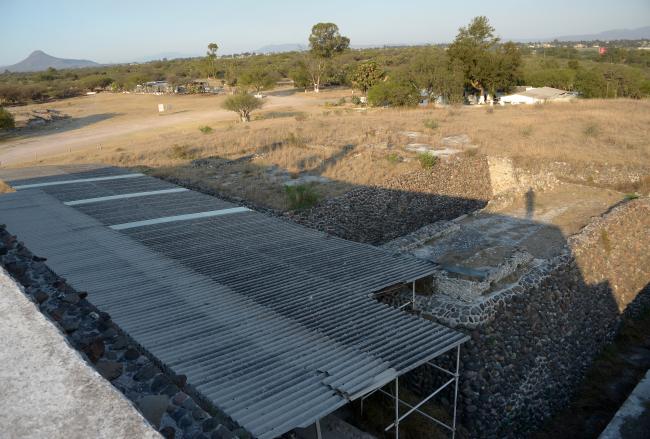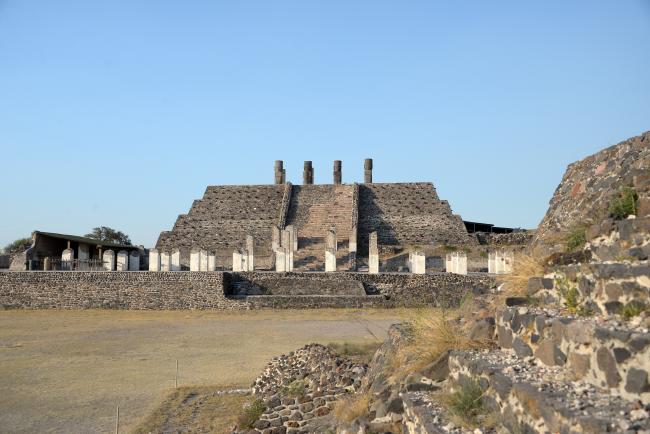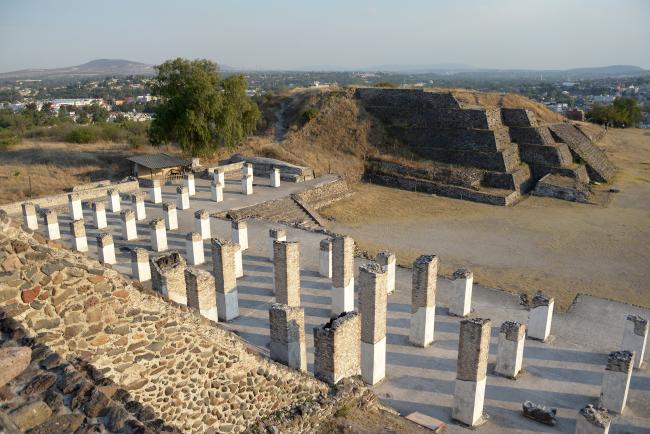
Conjunto Quetzalcóatl
At the entrance of the site, one can see part of the extensive living areas that surrounded the ceremonial center. This type of houses, where most of the population lived, consisted of two or three rooms, usually quite small.
Coatepantli, Snake Wall: It is so called because of its resemblance to the walls or “murallas” with sculptures of snakes that surrounded many Aztec buildings. It is possible that it was dedicated to Tlahuizcalpantecuhtli, one of the invocations of Quetzalcoatl as “Morning Star”, by the battlements of its superior part, that represent snails cut transversely, symbol associated to Venus. It contains three rows of friezes, the central one shows serpents that devour semi-disembodied individuals, who would represent the soul of the warriors; the others have staggered fretwork.
Ball Court 1: It is located outside the ceremonial zone of Tula Grande, but associated to it in the north end. It consists of a large courtyard in the shape of an “I” delimited by walls that rise on benches. This building would have been decorated with carved stones alluding to the players with their attire.
Palace of the Columns or Burnt Palace: It is known as Palacio Quemado because of the evidence of fire found. However, this building, more than for habitation, would function as a public-administrative structure or a kind of market. It is large and consists of three rooms, each with its own access and an internal courtyard, surrounded by columns to support the ceilings. In its interior there are remains of benches that were decorated with polychrome tombstones in which warriors with spears and shields are observed. The cornice of these benches is decorated with rows of serpents, some of them feathered, others represent Mixcoatl, “Serpent of clouds”, because of the symbol of clouds that they show.
The benches described would have been seats for the priests or lords who congregated there. Likewise, there is still evidence of some altars and tlecuiles, used to make fire. In the center room there is a stone sculpture called Chac Mool, characteristic of Tula and other regions of Mesoamerica; the character is lying down and holds in his belly a container to place offerings, so it is considered a bearer of the same for the gods.
Palace of Quetzalcoatl: Although now only some remains are preserved, fragments of the floors and walls of this building attached to the Temple of Tlahuizcalpantecuhtli, which would be the room of his priests, are clearly observed. For its architectural distribution, with a courtyard in the center surrounded by columns, to some extent resembles the rooms of the Palace of the Columns. During its exploration, remains of rooms and corridors built with adobe walls were found. Of these elements, only one corridor is preserved on the outside, where the remains of an altar decorated with carved and polychrome slabs can still be seen.
Pyramid B or Temple of Tlahuizcalpantecuhtli: It is a pyramidal base formed by several staggered bodies, originally covered with carved stones. Those still preserved have motifs of eagles and vultures devouring bloody hearts; these reliefs alternate with images of a human face emerging from the jaws of a snake, which is one of the invocations of Quetzalcoatl as “Lord of the Dawn” or Tlahuizcalpantecuhtli. On the cornice-boards there are also tombstones showing a procession of jaguars and coyotes, some with collars.
At the top of the structure are sculptures called Atlantes, originally found to the north of the building and placed in their present position by archaeologists, who considered that they must have supported the temple located there. The Atlantes represent Toltec warriors with their attire: the atlatl or spear-thrower, in their right hand; a bundle of arrows; a butterfly-shaped pectoral on their chest; a kilt with a large knotted belt in front; and, at the back, a solar disk. In addition to these sculptures, some pillars were located, also placed at the top of the building with the representation of a character with a bundle of arrows, identified as Quetzalcoatl, and the figure of a cipactli, that is to say, a crocodile or lizard. For the described decorative elements it is clear that this temple was built in honor of the main Toltec deity, Quetzalcoatl.
Vestibule: It extends along the south side of the described buildings. It is characterized by the abundant presence of columns or pillars that supported the roof, which is no longer preserved. The building is limited by adobe walls with attached sidewalks. These still retain engraved and polychrome slabs in several sections, where a procession of warriors or priests - armed with shields and darts - is represented, carrying a staff in their hands, while on the cornice there is a feathered rattlesnake.


